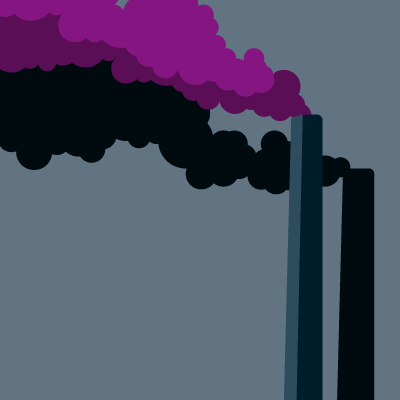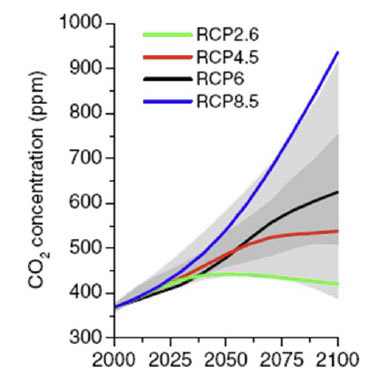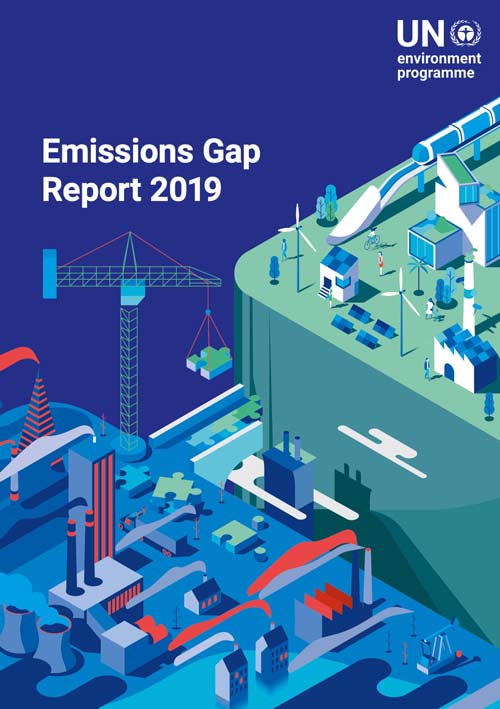
In AIR's white paper, Climate Change Impacts on Extreme Weather, we made several references to Representative Concentration Pathways, or RCPs. In the world of climate research, acronyms abound, but this one is particularly interesting perhaps because, as a catastrophe modeler, scenarios are near and dear to my heart.
In 2014, as part of its fifth assessment report, the International Panel on Climate Change (IPCC) adopted four potential trajectories of atmospheric greenhouse gas (GHG) concentrations over the coming decades. While they might have been more helpfully labeled as, for example, “most optimistic” to “most pessimistic,” they were in fact labeled according to values of radiative forcing, which is the difference between energy (in the form of sunlight) absorbed by Earth and energy radiated from Earth's surface back into space. The greater the difference, the more the Earth warms. The figure depicts the IPCC's four RCPs. (Gray areas indicate the 98th and 90th percentiles.)

RCPs and Warming Surface Temperatures
How do these RCPs translate to global surface temperatures? First it should be said that temperatures are expected to rise under all scenarios. Beyond that, the outlook becomes more uncertain. Under RCP2.6, for example, which represents the largest reductions in GHGs, temperatures will likely increase by between 0.3°C and 1.7°C by 2100. Under another moderate scenario, RCP4.5, temperatures are expected to rise between 1.1°C and 2.6°C. The least stringent RCP8.5 assumes high and growing GHG emissions with little effort to constrain them. Under that scenario, global temperatures would rise between 2.6°C and 4.8°C by the end of the century. It’s important to note that these are globally averaged temperature increases; land surface temperatures are hotter than sea surface temperatures, and there will be large variation, with some regions experiencing significantly higher temperatures than others.
Corresponding impacts on global tropical cyclone activity by 2100 in terms of the Power Dissipation Index (PDI), which is an integrated measure of activity over a season, is projected to increase anywhere from 40% for RCP 2.6 to over 100% for RCP 8.5.
The Paris Climate Agreement of 2015 set a goal of limiting the rise of Earth's temperature to "well below 2°C" and to pursue efforts to limit the rise to 1.5°C. Each country that was party to the agreement committed to Nationally Determined Contributions (NDCs) in the form of GHG reductions that, if honored, would put them broadly on the RCP 4.5 pathway toward achieving the first goal (<2°C). The more aggressive goal of 1.5°C would necessitate following a pathway even more stringent than RCP2.6. Thus, after the Paris Climate Agreement was signed, the four original RCPs were augmented by RCP1.9 to represent a pathway consistent with warming of 1.5°C.
What pathway are we on?
The UN Environment Programme's Emissions Gap Report, which is issued each year at about this time, offers the best insight into this topic. This report assesses the gap between where global GHG emissions are headed and where they need to be to achieve the 2°C/1.5°C targets of the Paris Climate Agreement.
That agreement assumed that GHG emissions would quickly peak and then almost immediately begin to fall, but that hasn't happened. While emissions remained stable in 2015 and 2016, they increased in 2017, setting a record high of 53.5 gigatons of CO2-equivalent, which includes emissions from fossil fuels, industry, and changes in land use, such as deforestation. That was followed by yet another record high in 2018.

The 2019 Emissions Gap Report was released today. It finds that unless signatory countries strengthen their NDCs (which are submitted every five years, making the next round of new or updated NDCs due in 2020)—and adhere to them—it is extremely unlikely that warming will be limited to 2°C and that the 1.5°C goal will be out of reach. Specifically, the report indicates that the current level of NDCs must be tripled to achieve the 2°C goal and increased fivefold to limit warming to 1.5°C.
Ultimately, it is difficult to say which RCP we are currently on, given the uncertainty inherent in each, as well as uncertainty regarding future technologies and political will. While the continued growth in emissions would suggest that RCP8.5 is well within the realm of possibility, that scenario also assumes that coal production will continue to grow, which is unlikely given that the price of solar energy has become competitive with and even cheaper than coal in many countries. Other good news is that falling battery costs may bring price parity between electric vehicles and internal combustion engines. On the other hand, the more moderate RCPs assume that we will soon deploy technologies to remove carbon from the atmosphere at industrial scale. The challenge will be to develop them, as they don’t currently exist.
Read my article "Insurers Have a Critical Role to Play in Mitigating Climate Change"



